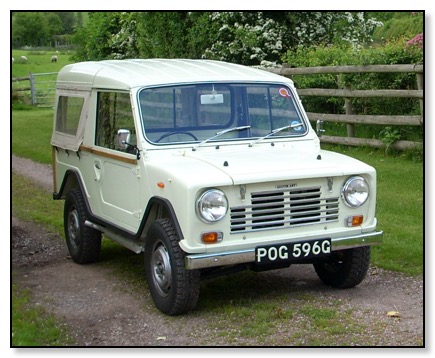RE: 2020 Land Rover Defender - first sighting!
Discussion
legless said:
I worked on the mid-2000s stillborn attempt to replace the Defender (L383 was the code name). It was to be built on the same T5 platform as the L319/L320 cousins, which would have retained a ladder chassis, but would have had IRS.
Interestingly, one of the programme assumptions at the time was that it would use the coil spring suspension of the base model Discovery rather than the more adjustable air springs, all driven by cost.
Ultimately, the programme was canned at a relatively early stage, as we just couldn't make the business case work for what was (and still is) a relatively tiny market for utility 4x4s.
The Defender was doubly hurt by the lack of product investment. It gradually lost its competitiveness, while also cementing the idea in people's heads about what a Defender should be (i.e. if it never changes, that's how it should be).
Try to imagine what a Defender would look like today, had it received the proper level of investment. When it went out of production 2 years ago, it was essentially the same vehicle as the 1980s 90 and 110. Normally, a car would have had at least 4 or even 5 ground-up redesigns in that period.
You mean like a Benz G-model?Interestingly, one of the programme assumptions at the time was that it would use the coil spring suspension of the base model Discovery rather than the more adjustable air springs, all driven by cost.
Ultimately, the programme was canned at a relatively early stage, as we just couldn't make the business case work for what was (and still is) a relatively tiny market for utility 4x4s.
The Defender was doubly hurt by the lack of product investment. It gradually lost its competitiveness, while also cementing the idea in people's heads about what a Defender should be (i.e. if it never changes, that's how it should be).
Try to imagine what a Defender would look like today, had it received the proper level of investment. When it went out of production 2 years ago, it was essentially the same vehicle as the 1980s 90 and 110. Normally, a car would have had at least 4 or even 5 ground-up redesigns in that period.
An entertaining read
My off road experience is limited and outdated
In the army in the late 80s we had a choice of several G Wagens; VW Iltis; unimogs and if wanted Leopard 2
If we were worried about the terrain; condition or weather up in the mountains (1.st mountain division specialist forces) we took the unimog... meeting with allies we noted that the humvees tended to get stuck as too wide and the landies were unreliable and broke down a lot... Austrian pinzgauers however were on par with the unimog not come across any japanese then
Moving on little has changed
The best off road vehicles from Europe seems the unimog and pinzgauer if you go by professional hard core users like army; mountain ambulance and fire services etc
To play with them it would need huge investment for a small specialist market and design a smallish; narrow half truck with portal axles etc. And compete with guys who have carved this market out for 30 odd years (the G4x4 was built by puch) and have a car which is slow and compromised on road
If not you are in the market for a life style car in the western world something RR have been doing well for about the same time
Their new defender will be a lifestyilish car which looks a bit rougher and better with a canoe on top than a range rover it might be a bit slower on and a bit further off road in the same way a standard G wagen will do this compared to a GL class
People will love it
Perhaps somebody like bowler will re design it...
Specialist will buy elsewhere
All imo
My off road experience is limited and outdated
In the army in the late 80s we had a choice of several G Wagens; VW Iltis; unimogs and if wanted Leopard 2
If we were worried about the terrain; condition or weather up in the mountains (1.st mountain division specialist forces) we took the unimog... meeting with allies we noted that the humvees tended to get stuck as too wide and the landies were unreliable and broke down a lot... Austrian pinzgauers however were on par with the unimog not come across any japanese then
Moving on little has changed
The best off road vehicles from Europe seems the unimog and pinzgauer if you go by professional hard core users like army; mountain ambulance and fire services etc
To play with them it would need huge investment for a small specialist market and design a smallish; narrow half truck with portal axles etc. And compete with guys who have carved this market out for 30 odd years (the G4x4 was built by puch) and have a car which is slow and compromised on road
If not you are in the market for a life style car in the western world something RR have been doing well for about the same time
Their new defender will be a lifestyilish car which looks a bit rougher and better with a canoe on top than a range rover it might be a bit slower on and a bit further off road in the same way a standard G wagen will do this compared to a GL class
People will love it
Perhaps somebody like bowler will re design it...
Specialist will buy elsewhere
All imo
I don't think the Unimog family of vehicles have a comparable model to the Defender, most versions are either specialist off road LGVs or tractors. They're amazing vehicles and I absolutely love them.
Pinzgauers are also extremely good, so good in fact that they replaced Defenders in several roles in the British Armed Forces. They are also British made and owned since 2000.
Utility land rovers were never really intended to occupy the extreme off road marketplace, they were originally envisioned as a cross country car, a road vehicle with a degree of off road ability. I really can't work out when people began to perceive them as anything else.
In response to this idea that the Land Rover succeeded merely because there was no other home grown competition this is simply not true. The 80 inch Land-Rover was entered in military trials in the early fifties. It was up against a specially designed vehicle, the Austin Champ and a modified version of the Land-Rover with the same engine as the Champ (Rolls Royce B40). The standard LR outperformed both other vehicles.
In the Sixties people had a choice between the Land-Rover and the Austin Gipsy, the latter being technologically more advanced. For some reason they didn't really take off and British Leyland ended production when Rover and Austin became part of the BL umbrella.
Pinzgauers are also extremely good, so good in fact that they replaced Defenders in several roles in the British Armed Forces. They are also British made and owned since 2000.
Utility land rovers were never really intended to occupy the extreme off road marketplace, they were originally envisioned as a cross country car, a road vehicle with a degree of off road ability. I really can't work out when people began to perceive them as anything else.
In response to this idea that the Land Rover succeeded merely because there was no other home grown competition this is simply not true. The 80 inch Land-Rover was entered in military trials in the early fifties. It was up against a specially designed vehicle, the Austin Champ and a modified version of the Land-Rover with the same engine as the Champ (Rolls Royce B40). The standard LR outperformed both other vehicles.
In the Sixties people had a choice between the Land-Rover and the Austin Gipsy, the latter being technologically more advanced. For some reason they didn't really take off and British Leyland ended production when Rover and Austin became part of the BL umbrella.
warch said:
In the Sixties people had a choice between the Land-Rover and the Austin Gipsy, the latter being technologically more advanced. For some reason they didn't really take off and British Leyland ended production when Rover and Austin became part of the BL umbrella.
The Gipsy failed **because** it was more technologically advanced. The selling point of the Mk1 Gipsy was that it had fully independent Flexitor suspension, designed by Alex Moulton (of Mini cone, Hydrolastic and Hydragas fame), which used rubber torsion springs mounting the wheels on trailing arms. This gave the Gipsy an excellent ride - far better than the jolty Land Rover which had been deliberately kept stiff-sprung because the Rover engineers felt that it would discourage people from driving the vehicles too fast over harsh terrain.And the Gipsy proved them right, because that's exactly what happened. The Gipsy could float over rough ground, absorbing bumps with Range Rover-like grace at speeds which would reduce a Land Rover to a pile of parts and rearrange the driver's internal organs. But the suspension units simply weren't up to the job and failed, while the usual bete-noir of fully independent suspension on cross-country vehicles also played a part, in that the Gipsy all-too-easily ran out of ground clearance, either grounding out on its chassis and differentials or, when driven fast, clouting the differential casing on the ground and splitting it open.
Which is shame because the Gipsy was, in many other ways, a far better product than the Land Rover. As well as its suspension the Gipsy also had a fully pressed-steel body rather than the bolt-together Meccano kit construction of the Land Rover, making it much less rattly and much quieter and more refined. The BMC engineers had also had the opportunity to look at some of the flaws in the Land Rover design, so the Gipsy featured a much wider tailgate and much smaller wheel boxes than the Land Rover, and also was able to break free of the restrictive small wheelbases that the Landy had inherited from the Jeep - the original SWB Gipsy had a 90-inch wheelbase while the LWB model had 111 inches between the axles, which were dimensions that the Land Rover wouldn't attain until the 1980s. The Gipsy was also able to borrow its gearbox and final drive from the BMC light commercial range so they were physically much more durable than the Rover items which had been adapted from 1930s Rover car parts.
But the Austin quickly gained a poor reputation due to its fragile suspension and supposedly poorer cross-country ability (which wasn't really the case) and the all-steel body was nowhere near as durable as the Landy's Birmabright so Gipsys quickly succumbed to rust. The Gipsy's one-piece body tub wasn't as versatile as the Land Rover's individual panels, meaning that BMC couldn't provide the multitude of body options that Rover did and the Gipsy wasn't as useful as a platform for building specialist vehicles on, which (as with the Defender in later years) proved the Land Rover's saving grace.
The Mk3 Gipsy had the option of traditional leaf springs and live axles and the Mk4 did away with the Flexitor system altogether but by then it was clear that it would not be a real challenger to the Land Rover. Aside from its technical flaws the Gipsy was going up against the Land Rover when the latter was at the peak of its global success - when you are going up against a competitor that's been around for nearly 20 years and has 90+ per cent of the market in some key territories then you have to have the right product, the right pricing and the right marketing/sales structure. BMC didn't have that. Ten years later the Japanese did.
Rover were sufficiently worried by the Gipsy that they built a number of Land Rover Series IIA prototypes with the independent front suspension and steering system from the Rover P4, just in case the idea of a comfortable utility vehicle caught on. The lingering influence of the Gipsy can be seen in Rover's Project One-Eleven, which was their proposal for a 'Series IV' Land Rover intended for launch in 1975 which was an all-new utility 4x4 using the same basic design and engineering features as the Range Rover. Unfortunately BL's financial collapse put the kybosh on that.
Edited by 2xChevrons on Sunday 17th February 15:18
DonkeyApple said:
Genuinely interesting. Thanks.
Thank you - glad you found it so. Do you know about BMC's other 'what if?' attempt at competing with Land Rover, the Austin Ant/Morris Mule?

This had its origins way back in the 1940s with a series of off-road vehicles Alec Issigonis designed for the Army - the Wolseley Mudlark and the Nuffield Gutty, which together formed the basis for what became the Austin Champ. Later, Issigonis designed the Mini Moke, which he was very fond of as he always liked designing a machine that was as functional and stripped-down as possible, and the Moke was basically a floorpan and subframes with nothing else. The Moke was supposed to be a highly-portable lightweight military vehicle but lacked the ground clearance and traction to perform properly. BMC also tried to sell it as a light utility vehicle rather in the mould of today's UTVs like the Kawasaki Mule and John Deere Gator, pitching it to smallholders, the horsey set, golf courses and the like. It didn't take.
So Issigonis went back to the drawing board and came up with the Ant, which he intended to do for utility 4x4s what the Mini had done for small saloon cars. It was a true monocoque with a 77-inch wheelbase and the whole car was only 3 inches longer than a Mini. It used a 1275cc A-Series engine mounted transversely usually driving the front wheels. Suspension was the same design as Issigonis had used on the Mudlark 20 years before - fully independent long-travel torsion bars. The Ant had an ingenious transmission system with selectable drive to the rear wheels via a transmission which also included a twin-range transfer box. Ground clearance with two passengers and a 600-lb payload was seven inches and the entire underside was protected by skid plates. Steering was by Mini-style rack and pinion, brakes were Austin 1300-sourced front discs/rear drums
So while the Ant wasn't as capable of extreme 4x4-ing as a Land Rover it would have been perfect for the majority of farms, smallholders, market gardeners, livery stables, vets, estate workers etc. etc. etc. in the UK let alone the military market and the export potential. It was really the first 'on-road off-roader' in that it drove and rode like a small car (albeit, by all accounts, a fairly noisy one because it lacked subframes so all the mechanical parts mount directly to the bodyshell). It was a market that was completely untapped outside ultra-basic little Japanese kei-class machines like the early Suzuki Jimny and the two-stroke Daihatsu Taft and the Ant was significantly better than those.
A pre-production batch of Ants were built in civilian and military specification and BMC even got as far as printing up brochures, handbooks and accessory catalogues. Unfortunately the entire idea was axed when all it needed was the final nod for production when BL was formed.
The Ant was developed at the same time that Issigonis was designing and building the BMC 9X prototype, which was basically a better Mk1 VW Polo six years before the Polo was actually launched. Talk about missed opportunities!
300bhp/ton said:
Shakermaker said:
So it appears to retain the side-opening door of the old model where the aperture appears much narrower than the width of the overall car
I guess it's quite a challenge to make the aperture wider than the width of the car though... 
2xChevrons said:
Thank you - glad you found it so.
Do you know about BMC's other 'what if?' attempt at competing with Land Rover, the Austin Ant/Morris Mule?

This had its origins way back in the 1940s with a series of off-road vehicles Alec Issigonis designed for the Army - the Wolseley Mudlark and the Nuffield Gutty, which together formed the basis for what became the Austin Champ. Later, Issigonis designed the Mini Moke, which he was very fond of as he always liked designing a machine that was as functional and stripped-down as possible, and the Moke was basically a floorpan and subframes with nothing else. The Moke was supposed to be a highly-portable lightweight military vehicle but lacked the ground clearance and traction to perform properly. BMC also tried to sell it as a light utility vehicle rather in the mould of today's UTVs like the Kawasaki Mule and John Deere Gator, pitching it to smallholders, the horsey set, golf courses and the like. It didn't take.
So Issigonis went back to the drawing board and came up with the Ant, which he intended to do for utility 4x4s what the Mini had done for small saloon cars. It was a true monocoque with a 77-inch wheelbase and the whole car was only 3 inches longer than a Mini. It used a 1275cc A-Series engine mounted transversely usually driving the front wheels. Suspension was the same design as Issigonis had used on the Mudlark 20 years before - fully independent long-travel torsion bars. The Ant had an ingenious transmission system with selectable drive to the rear wheels via a transmission which also included a twin-range transfer box. Ground clearance with two passengers and a 600-lb payload was seven inches and the entire underside was protected by skid plates. Steering was by Mini-style rack and pinion, brakes were Austin 1300-sourced front discs/rear drums
So while the Ant wasn't as capable of extreme 4x4-ing as a Land Rover it would have been perfect for the majority of farms, smallholders, market gardeners, livery stables, vets, estate workers etc. etc. etc. in the UK let alone the military market and the export potential. It was really the first 'on-road off-roader' in that it drove and rode like a small car (albeit, by all accounts, a fairly noisy one because it lacked subframes so all the mechanical parts mount directly to the bodyshell). It was a market that was completely untapped outside ultra-basic little Japanese kei-class machines like the early Suzuki Jimny and the two-stroke Daihatsu Taft and the Ant was significantly better than those.
A pre-production batch of Ants were built in civilian and military specification and BMC even got as far as printing up brochures, handbooks and accessory catalogues. Unfortunately the entire idea was axed when all it needed was the final nod for production when BL was formed.
The Ant was developed at the same time that Issigonis was designing and building the BMC 9X prototype, which was basically a better Mk1 VW Polo six years before the Polo was actually launched. Talk about missed opportunities!
Interesting, have to say I didn't really know about these. Was there ever one on display at Gaydon?Do you know about BMC's other 'what if?' attempt at competing with Land Rover, the Austin Ant/Morris Mule?

This had its origins way back in the 1940s with a series of off-road vehicles Alec Issigonis designed for the Army - the Wolseley Mudlark and the Nuffield Gutty, which together formed the basis for what became the Austin Champ. Later, Issigonis designed the Mini Moke, which he was very fond of as he always liked designing a machine that was as functional and stripped-down as possible, and the Moke was basically a floorpan and subframes with nothing else. The Moke was supposed to be a highly-portable lightweight military vehicle but lacked the ground clearance and traction to perform properly. BMC also tried to sell it as a light utility vehicle rather in the mould of today's UTVs like the Kawasaki Mule and John Deere Gator, pitching it to smallholders, the horsey set, golf courses and the like. It didn't take.
So Issigonis went back to the drawing board and came up with the Ant, which he intended to do for utility 4x4s what the Mini had done for small saloon cars. It was a true monocoque with a 77-inch wheelbase and the whole car was only 3 inches longer than a Mini. It used a 1275cc A-Series engine mounted transversely usually driving the front wheels. Suspension was the same design as Issigonis had used on the Mudlark 20 years before - fully independent long-travel torsion bars. The Ant had an ingenious transmission system with selectable drive to the rear wheels via a transmission which also included a twin-range transfer box. Ground clearance with two passengers and a 600-lb payload was seven inches and the entire underside was protected by skid plates. Steering was by Mini-style rack and pinion, brakes were Austin 1300-sourced front discs/rear drums
So while the Ant wasn't as capable of extreme 4x4-ing as a Land Rover it would have been perfect for the majority of farms, smallholders, market gardeners, livery stables, vets, estate workers etc. etc. etc. in the UK let alone the military market and the export potential. It was really the first 'on-road off-roader' in that it drove and rode like a small car (albeit, by all accounts, a fairly noisy one because it lacked subframes so all the mechanical parts mount directly to the bodyshell). It was a market that was completely untapped outside ultra-basic little Japanese kei-class machines like the early Suzuki Jimny and the two-stroke Daihatsu Taft and the Ant was significantly better than those.
A pre-production batch of Ants were built in civilian and military specification and BMC even got as far as printing up brochures, handbooks and accessory catalogues. Unfortunately the entire idea was axed when all it needed was the final nod for production when BL was formed.
The Ant was developed at the same time that Issigonis was designing and building the BMC 9X prototype, which was basically a better Mk1 VW Polo six years before the Polo was actually launched. Talk about missed opportunities!
kdri155 said:
Well I've just spotted the new defender in its disguise driving through my home town of Rhyl, it was wearing its familiar zebra pattern for disguise and carrying a few external and roof mounted sensors.
Was the driver doing 5mph, with his head out the window, towing a plough? Brooking10 said:
Point.
Missed.
Companies that are based on building cheap and simple cars are able to cost effectively make cheap and simple cars.
Companies that are based on making expensive and complex cars cannot suddenly, or even over a protracted period of time, cost effectively become manufacturers of cheap and simple cars.
The inverse of course equally applies.
Land Rover can't even built a reliable simple car.Missed.
Companies that are based on building cheap and simple cars are able to cost effectively make cheap and simple cars.
Companies that are based on making expensive and complex cars cannot suddenly, or even over a protracted period of time, cost effectively become manufacturers of cheap and simple cars.
The inverse of course equally applies.
What makes you think they can build a reliable complicated one?
Gassing Station | General Gassing | Top of Page | What's New | My Stuff





 |https://thumbsnap.com/tk14rpZH[/url][url]
|https://thumbsnap.com/tk14rpZH[/url][url] |https://thumbsnap.com/TH4fuj0v[/url]
|https://thumbsnap.com/TH4fuj0v[/url]